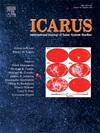The bright-field grinding tomography of coarse-grained calcium‑aluminum-rich inclusions in the Allende meteorite
IF 3
2区 物理与天体物理
Q2 ASTRONOMY & ASTROPHYSICS
引用次数: 0
Abstract
The evolution associated with coagulation/fragmentation processes of dust to planetesimals in the protosolar disk is the critical phase of planet formation in the Solar System. The meteoritic components, such as calcium‑aluminum-rich inclusions (CAIs), will provide essential constraints on the coagulation/fragmentation process in the early stage of the disk. We applied the bright-field grinding tomography method to an Allende meteorite (CV3) slab to visualize the coarse-grained CAIs (CG-CAIs) in a colorized 3D model with high spatial resolution. We found four mm-scale CG-CAIs that experienced deformation and/or fragmentation processes within ∼1.8 × 103 mm3 Allende slab. An angular-shaped CG-CAI's surface showed the anisotropy of red-gray and white sides, which suggests that the fragmentation results in the loss of the primitive Wark-Lovering rim. We also found a vesicular-shaped CG-CAI, which indicates that the fracturing and complex formation process of this CG-CAI likely proceeded prior to the accretion of the Wark-Lovering rim. Our observations reveal that the fragmentation of Allende CAIs occurred during the parent body accretion stage and also in the protosolar disk.
Allende陨石中粗粒富钙铝包裹体的亮场磨削层析成像
原太阳盘中尘埃向星子凝结/碎裂的演化过程是太阳系行星形成的关键阶段。陨石成分,如富钙铝包裹体(CAIs),将对圆盘早期的凝固/破碎过程提供必要的限制。我们对一块Allende陨石(CV3)板应用了亮场磨削层析成像方法,以高空间分辨率的彩色3D模型显示了粗粒CAIs (CG-CAIs)。我们发现4个mm尺度的cg - cai在~ 1.8 × 103 mm3 Allende板内经历了变形和/或破碎过程。CG-CAI的角状表面呈现红灰色和白色的各向异性,表明破碎导致原始的沃克-洛夫林边缘丢失。我们还发现了一个囊状的CG-CAI,这表明该CG-CAI的破裂和复杂形成过程可能发生在沃克-洛夫林边缘的增生之前。我们的观测结果表明,阿连德cai的破碎发生在母体吸积阶段,也发生在原太阳盘。
本文章由计算机程序翻译,如有差异,请以英文原文为准。
求助全文
约1分钟内获得全文
求助全文
来源期刊

Icarus
地学天文-天文与天体物理
CiteScore
6.30
自引率
18.80%
发文量
356
审稿时长
2-4 weeks
期刊介绍:
Icarus is devoted to the publication of original contributions in the field of Solar System studies. Manuscripts reporting the results of new research - observational, experimental, or theoretical - concerning the astronomy, geology, meteorology, physics, chemistry, biology, and other scientific aspects of our Solar System or extrasolar systems are welcome. The journal generally does not publish papers devoted exclusively to the Sun, the Earth, celestial mechanics, meteoritics, or astrophysics. Icarus does not publish papers that provide "improved" versions of Bode''s law, or other numerical relations, without a sound physical basis. Icarus does not publish meeting announcements or general notices. Reviews, historical papers, and manuscripts describing spacecraft instrumentation may be considered, but only with prior approval of the editor. An entire issue of the journal is occasionally devoted to a single subject, usually arising from a conference on the same topic. The language of publication is English. American or British usage is accepted, but not a mixture of these.
 求助内容:
求助内容: 应助结果提醒方式:
应助结果提醒方式:


